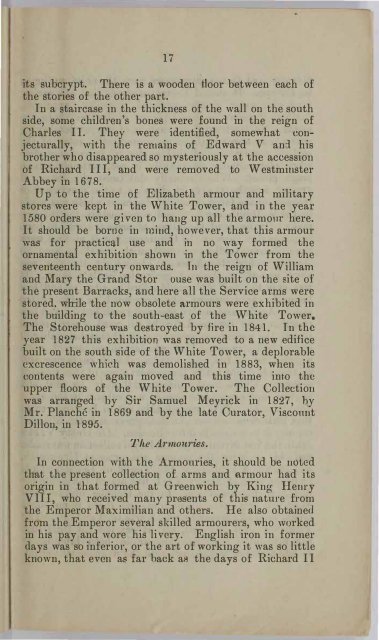Authorised Guide to the Tower of London
You also want an ePaper? Increase the reach of your titles
YUMPU automatically turns print PDFs into web optimized ePapers that Google loves.
17<br />
its subcrypt. There is a wooden tloor between each <strong>of</strong><br />
<strong>the</strong> s<strong>to</strong>ries <strong>of</strong> <strong>the</strong> o<strong>the</strong>r part.<br />
In a staircase in <strong>the</strong> thickness <strong>of</strong> <strong>the</strong> wall on <strong>the</strong> south<br />
side, some children's bones were found in <strong>the</strong> reign <strong>of</strong><br />
Charles II. They were identified, somewhat conjecturally,<br />
with <strong>the</strong> remains <strong>of</strong> Edward · V an:l his<br />
bro<strong>the</strong>r who disappeared so mysteriously at <strong>the</strong> accession<br />
<strong>of</strong> Richard III, and we1·e removed <strong>to</strong> Westminster<br />
Abbey in 1678.<br />
Up <strong>to</strong> <strong>the</strong> time <strong>of</strong> Elizabeth armour and military<br />
s<strong>to</strong>res were kept in <strong>the</strong> White <strong>Tower</strong>, and in <strong>the</strong> year<br />
1580 orders were given <strong>to</strong> hang up all <strong>the</strong> armour here.<br />
It should be borne in mind, however, that this armour<br />
was for practica,l use and in no way formed <strong>the</strong><br />
ornamental exhibition shown in <strong>the</strong> <strong>Tower</strong> from <strong>the</strong><br />
seventeenth century onwards. In <strong>the</strong> reign <strong>of</strong> William<br />
and Mary <strong>the</strong> Grand S<strong>to</strong>r ouse was built on <strong>the</strong> site <strong>of</strong><br />
<strong>the</strong> present Barracks, and here all <strong>the</strong> Service arms were<br />
s<strong>to</strong>red, while <strong>the</strong> now obsolete armours were exhibited in<br />
<strong>the</strong> building <strong>to</strong> <strong>the</strong> south-east <strong>of</strong> <strong>the</strong> White <strong>Tower</strong>.<br />
The S<strong>to</strong>rehouse was destroyed by fire in 1841. In <strong>the</strong><br />
year 1827 this exhibition was removed <strong>to</strong> a new edifice<br />
built on <strong>the</strong> south side <strong>of</strong> <strong>the</strong> White <strong>Tower</strong>, a deplorable<br />
excrescence which was demolished in 1883, when its<br />
contents were again moved and this time in<strong>to</strong> <strong>the</strong><br />
upper floors <strong>of</strong> <strong>the</strong> White <strong>Tower</strong>. The Collection<br />
was arranged by Sir Samuel Meyrick in 1827, Qy<br />
Mr. Planche in 1869 and by <strong>the</strong> late Cura<strong>to</strong>r, Viscount<br />
Dillon, in 1895.<br />
The Armouries.<br />
In connection with <strong>the</strong> Armouries, it should be noted<br />
that <strong>the</strong> present collection <strong>of</strong> arms and armour had its<br />
origin in that formed at Greenwich by King Henry<br />
VIII, who received many presents <strong>of</strong> this nature from<br />
<strong>the</strong> Emperor Maximilian and o<strong>the</strong>rs. He also obtained<br />
from <strong>the</strong> Emperor several skilled armourers, who worked<br />
in his pay and wore his livery. English iron in former<br />
days was so inferior, or <strong>the</strong> art <strong>of</strong> working it was so little<br />
known, that even as far back as <strong>the</strong> days <strong>of</strong> Richard II



